India, which imports around 85% of its crude oil requirements, has launched “Mission Anveshan” to reduce import dependency and strengthen domestic energy security. The programme, introduced by the Ministry of Petroleum and Natural Gas in FY2025, incentivizes 2D seismic surveys across uncharted onshore sedimentary basins. With a total outlay of ₹720 crore over two years (FY2025–FY2026), the initiative targets 20,275-line kilometres of survey data across seven key basins: Ganga-Punjab, Rajasthan, Saurashtra, Deccan Syncline, Cuddapah, Krishna-Godavari, and Chhattisgarh.
The mission is a strategic extension of the National Seismic Programme (NSP), which focusses on acquiring, processing, and interpreting subsurface data to identify untapped hydrocarbon reserves. These surveys are vital for evaluating India’s underexplored and Category-II & III sedimentary basins, which collectively hold a significant share of the estimated 42 billion tonnes of hydrocarbon resources yet to be monetized. By unlocking these reserves, India aims to reduce its energy trade deficit and enhance energy availability for growth.
Public Sector Undertakings (PSUs) such as Oil and Natural Gas Corporation (ONGC) and Oil India Ltd. are spearheading implementation. Oil India has made notable progress by completing around 1,683 line-kilometres of 2D seismic surveys across the Rajasthan and Ganga-Punjab basins. ONGC, despite some delays due to contract issues, has commenced experimental surveys in the Cuddapah region. The Geological Survey of India and the Directorate General of Hydrocarbons (DGH) are also supporting this effort through regulatory and technical assistance.
To enhance data resolution and reduce geological risk, the government is also prioritizing the use of advanced 3D seismic survey techniques. These technologies provide greater subsurface imaging accuracy, leading to more precise reservoir mapping and increased investor confidence. This move is expected to generate employment opportunities in data acquisition, geoscience analysis, and logistics in remote regions.
Recognizing the importance of indigenous energy development, the government is considering extending the programme to FY2027. This would allow broader exploration and better data acquisition in difficult terrains, further supporting India’s long-term goal of achieving energy self-reliance under the Atmanirbhar Bharat initiative. Thus, Mission Anveshan is not merely a technical survey programme—it is a strategic policy move to unlock India’s energy potential, catalyse investment in exploration, and build a secure, self-reliant energy future.

